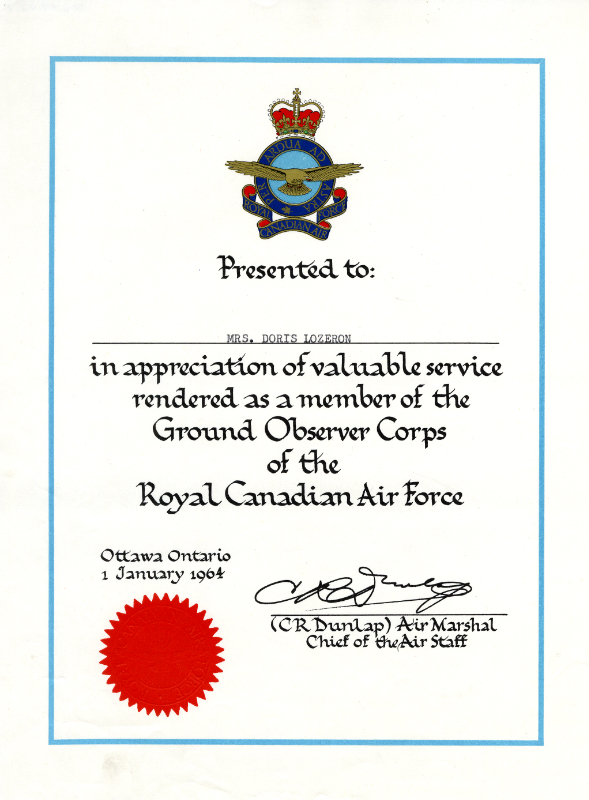Image: Dora’s Ground Observer Certificate (SPRA 006.01.02.01)
Dora Koberg arrived in the Peace Country in 1918, with the Thomas family from St. Paul’s, Minnesota. She had been born in Berlin, Iowa and attended a Presbyterian Teachers’ college in Minnesota. In the Peace Country, she met Pierre Lozeron and married him in 1926. They raised three children on their farm on the Emerson Trail. The children attended Canuck School and later high school in Grande Prairie. Paul, born in 1927, became a medical doctor in Neuchatel, Switzerland; Homer, born in 1934, became a biochemist in the United States; and Andre, born in 1939, received a degree in agriculture from the University of Alberta and became a farm commentator for the Canadian Broadcasting Corporation.
After World War II, Dora became a member of the Royal Canadian Air Force Ground Observer Corps. This was when the DEW Line (Distant Early Warning) and Radar stations were being set up across Canada, one of which was the Pinetree Line Trumpeter Station on Saskatoon Mountain.
The history of this group can be found on the Canadian Military History site by Bruce Forsythe:
“During the 1950s, North America was under constant watch for attack by Russian bombers flying over the North Pole. To counter this threat, three lines of early warning radar stations were built across Canada…. and the RCAF Ground Observer Corps was conceived as a manual backup system in 1951. The Ground Observer Corps [had] a network of observation posts across Canada manned by civilian volunteers. Each post would observe and report aircraft movements to their respective filter centres, which would confirm the report before passing it on to Air Defence Command. If necessary, fighter jets would be dispatched to intercept the aircraft. These unpaid civilians came from a variety of professions, including… housewives, students or anyone with spare time and a willingness to watch the skies for hours upon hours. The observers were trained not only to recognize aircraft by sight, but also by their silhouettes under low light conditions. They would man these posts on a 24-hour basis, often using their own visual or audio equipment…”
A news article in the Herald-Tribune on August 17, 1956 gives us a little more insight into Dora’s unusual occupation: “An RCAF announcement says Mrs. Lozeron, chief observer of the RCAF Ground Observer Corps at Canuck, ‘has brought her post into Top Three rating for reporting aircraft movements in northern Canada during the month of July.’ Noting that she has been serving in the Ground Observer for little more than a month, RCAF officials call Mrs. Lozeron’s record ‘a tremendous achievement.’”
The RCAF Ground Observer Corps north of the 55th parallel continued operating until January 12, 1964. This was one of the more unusual ways in which women helped their community and country.
This article first appeared in the September 2016 issue of Telling Our Stories.
